Wendy Chidester, painter
A motherlode of typewriters, respect for vintage items, and a fortuitous weather event
Dear Diary:
I hope to score an interview with artist Wendy Chidester. So, I called her to request an interview. There are lots of eights and nines in her phone number, so dialing was a real chore.
Dear Diary:
I’m excited! Wendy invited me to visit her studio in Helper, UT, for an interview. I’ll need to pack my suitcases with my traveling shoes and sharpen some pencils so I can take detailed notes.
Also, I need to decide which camera to bring so I can capture Wendy in action. I mustn’t forget to bring film and flashbulbs.
Dear Diary:
I enjoyed my interview with Wendy and now I’m back writing my story. It’s a good thing I took touch typing in seventh grade.
Considering the time I’ve already spent typing at a desk, I need to get outside. Should I go roller skating or ride my bike?
Dear Diary:
I wish I could paint so exquisitely as Wendy does.
OK now. Onward with more serious journalism instead of diary entries.
Wendy Chidester focuses on painting vintage items and splits time between her home studio in Draper, UT, and her studio in a 100-year-old building on Main Street in Helper, UT. In Helper, several artists have bought older buildings and made them their studios. Wendy says it has proven to be a very supportive artist community for all who work there. She studied art at the University of Utah, receiving her BFA in 1988, and was painting landscapes until the fateful day that changed everything. Read on.
When did you start painting vintage objects?
I was focused on plein air painting in the early 2000s. One day while setting up my easel to paint the Blue Hill Dairy just outside of Helper, it started to rain, and I went into an antique shop to avoid getting wet. I found an old camera from the 1950s and took it back to my studio and started painting it. I fell in love with painting it and thought about the story behind the camera: Who owned it, what pictures it’s taken, and how it's been replaced by our phones. I thought, why am I dealing with the weather, changing shadows, getting a sunburn, and bugs in my paint? That’s when I decided to stop painting the landscape plein air and switched to painting still life.
What is the art scene like where you are?
Helper, UT, is a thriving, little art community. Dave Dornan was the first to buy a building to use as an art studio and place to teach workshops. I studied with Dornan at the University of Utah while working on my BFA and then 20 years later found him in Helper. I took several workshops from him and then did an apprenticeship under him. He has been a major influence on my still life work today. Several well-known artists are also working in buildings along Main Street such as Ben Steele, Anne Kaferle, Kathleen Royster, Anne Morgan Jesperson, and Charles Callis.
Your paintings have a magical quality to them despite appearing realistic. How are you achieving that effect?
I want to make these items look like icons. Often, I'll paint a single subject, such as a camera, put a single light source on my still life stand and stage it so that the image sparkles. I strive to make the setting as dramatic as possible.
The background is kept simple so that the viewer’s eye goes right to the object. The last thing I do is add highlights that are strong because of the single light source raking across the object. The object wouldn’t have the sparkle it does if it were seen in daylight alone.
Hopefully, the painting has a magical quality evoking a memory or a story. Often people will look at a painting of mine, slow down, and say, “I remember my grandfather having a camera like that," or “my dad was a writer, and used a typewriter similar to this one.” [OK, readers, tell me your typewriter or other vintage object story in the comments. Here’s mine: My dad, now 93, won a high school journalism contest and was presented with a Remington typewriter by actress Loretta Young.]
Please describe your painting process.
I set up the object on a still life stand, which is about three feet away from me, and set up one light getting the shadows where I want them. Then I start blocking it in with a brush and paint, I don’t draw it with pencil. So, when painting a typewriter for example, I block in a square because the typewriter itself is square-ish. Then I start adding things, chipping away at the square as I go.
Once it's more precise, I destroy it, because I don't want the energy to be lost. To destroy it, I splatter paint back into it, scratching the surface with the back ends of brushes, and then apply glazes to add color and richness back into the painting.
Despite destroying it with this process, I can still see the underlying drawing. But if you look at the objects closely, they almost look abstract because of all the scatches, splatters, and glazes. From a distance, the paintings look pretty realistic, but not photorealistic.
How do you approach glazing? I saw a video of you glazing an Underwood typewriter. The typewriter went from looking kind of chaotic to looking just exactly right. So how did you do that?
It can look chaotic [at the intermediate stage], but all of my drawing is still there. Once I start darkening some areas with glazes, such as around the typewriter keys, and then apply highlights, the details start to pop and the item looks three-dimensional. I don't always glaze the whole painting. I like the richness the painting has when it is glazed with different colors in different areas. In mixing a glaze, I use Liquin to thin down the paint.
Do you own most of the items that you're painting?
I own quite a few. I have about ten tricycles you can see hanging on my studio wall. I also have glass cases that house the bottles, old binoculars, toys, oil cans, fans, and phones. I have a collection of 20 typewriters! [She smiles.]
Wendy mentioned she had been corresponding with Don Gale, a Utah journalist, who apparently has 65 typewriters in his collection and is a pen pal with Tom Hanks, a well-known typewriter writer and collector. Wendy has not crossed paths with Tom Hanks. [I bet he would appreciate Wendy’s typewriter paintings. Therefore, I am going to send him a link to this article.] The day after our interview, Wendy drove to Salt Lake City in a snowstorm to receive 15 of 30 typewriters she is purchasing from Don Gale. She had to wrap each one in a towel to protect it from the elements. She’s very excited about painting them.
I imagine that your interest in vintage objects has brought adventures.
When I had a show in Santa Fe, a man invited my husband and I to his home in Wichita Falls, TX, to see his collection of candlestick phones. He gave us white gloves to wear, left his home, and trusted us with his priceless phone collection, many of which were one of a kind. I was nervous about handling the phones. My husband and I stayed there all night photographing his phone collection! We finished around 5:30 in the morning.
Why is there so much interest around vintage objects at this time?
Many of us have memories of these items, and things have changed so fast. Phones and technology have taken over much of what I paint. Many of the vintage items are intricate and beautiful art pieces in and of themselves. Also, everything we have now is made to only last a few years as opposed to what I am painting, which were made to last forever.
Do you work on commissions?
Yes, I’m currently working on a bicycle for an avid bike rider in San Francisco. The painting is a surprise birthday gift. I've painted motorcycles such as old Harley-Davidsons from the early 1900s, but he wants a regular bicycle from the 1950s. I was looking at bicycles on Facebook and shipping a bike from another state gets complicated. Then I went to a bike shop about an hour and a half away from me and they had some antique bikes hanging in the rafters. I talked them into letting me borrow one of those bikes for a couple of weeks. That was a fun find.

Tell me about painting motorcycles. Did you get to borrow one?
There's a motorcycle museum, Vintage Motors, in Helper, UT, where I have a studio, and they have a couple dozen or more Harley-Davidsons from the early 1900s. I was also fortunate to find another motorcycle museum—Legends Motor Co—in Springville, UT, which houses a small restaurant surrounded by these beautiful bikes. I’ve taken detailed photos of many of their motorcycles to paint from. These paintings are 28” x 60” or larger. I paint them on a large scale because of the large amount of detail.
Tell me about your use of color.
I often paint machines that are made of a lot of black metal, and I try to pull as much color in as I can. Maybe that's where the magic comes in—if you look closely you can see dark reds and blues in the black behind the typewriter keys, but you don't see it at first glance. To bring an item to life, I enjoy adding some unexpected colors.
You will often combine a variety of items, such as a stack of suitcases with cameras arranged on top. There’s one arrangement in particular that’s really fun, called “Flower Power.” How did that one come about?
“Flower Power” was a breakthrough painting for me because of the play on my usual subject matter. Anne Jespersen of AMJ Fine Arts invited me to exhibit in her themed show, Flowers Everywhere. I wanted to paint something for the show in my own genre rather than a typical floral painting.
The idea of “Flower Power” came to me in the middle of the night—painting a 1960s-70s montage piece with the iconic hippie flower stickers would fit into her theme. I focused on the still life subjects I am known for, but added the hippie flower stickers pasted all over the luggage.
Viewers responded positively to the painting. It conjured up memories for those who had lived during this period. The president of Zions Bank purchased the painting during the opening night of the show. Since then, I have painted pedal cars and more luggage with stickers of peace signs, flowers, and hearts.
I almost never ask this, but how long do the paintings with multiple objects take to paint? There are some that have at least 10 cameras in them!
I'm usually working on four or five different paintings at a time. So, it’s difficult to answer this question. I work on a painting for a couple hours, and then I set it aside to dry before I put the next layer on, or I end up needing a break from all the detail and start a new painting because I start to get lost in all the intricacies of the object and have to take a break.
Because I’m working on several paintings at a time, it may take around three to four weeks to complete one of the montage paintings.
Do you ever go back to painting landscapes?
No. Sometimes I think it might be fun to go outside and paint with another artist or to paint the scenery while traveling. But I am so into painting still lifes that I don't have a desire to do anything else right now. As long as I'm captivated by what I'm painting, then I'm going to just keep painting it. People ask me if I get tired of painting typewriters. Because they are all so different, it’s exciting for me to continue to paint typewriters. I love what I do and feel fortunate to be able to make a living with something I love doing.
Do you have a painting routine or schedule?
I like to paint in the morning and into the afternoon before taking a break. In the evening, I will often go back to the studio to glaze a painting or two so they will be dry and ready to put the next layer on the following day. I paint almost every day of the week and try to keep all my appointments to one day so on the other days I can just paint and not have to worry about time constraints. My studio is separate from my house here in Draper, and it has its own ventilation system so I’m not continually breathing in the paint fumes. I also have the studio in Helper.
My choice of studios to work from is dependent on the weather. Helper is located at the top of Spanish Fork Canyon and the road conditions in the winter make it a little sketchy at times to drive on. I paint mostly at my Draper studio in the winter and spend more of the summer at my studio in Helper.
Do you like to cook?
Yes, but I'm too busy painting to give a lot of time to it.
Who are some artists or creative people you admire?
Mark Rothko, because I love the colors he uses. Dave Dornan has been a huge influence on how I paint. I admire Rembrandt because his darks have so much color in them, but if you see his paintings as prints or color plates, you don't see those colors, you just see the areas as black. I’m doing the same thing with putting color in dark areas, particularly when I paint objects that are made of black metal.
What's been your most captivating art viewing experience?
Recently, my husband and I went to Italy and saw The Last Supper. Visitors are only allowed to view the work for 20 minutes. It was unbelievable to see the details that you don’t see in books or prints of the painting.
What's your favorite piece of art that you own?
Dave Dornan did a painting for me at a time when I was juggling family commitments and also taking workshops from him. My life was a little hectic at the time and I was fighting for blocks of time to paint. The painting depicts that period of time in my life. It shows several items you would see in a typical artist studio—paint-splattered bottles, well-worn brushes, a used palette knife, a palette, used painting rags, and in the center of the composition is a red plastic ketchup squeeze bottle with a waitress on it, covered in paint. This was me at that time, trying to find a balance between being an artist and being a mom. It currently hangs in my home, reminding me of how lucky I was to have been able to continue painting!
I've interviewed several women who either put their art on hold or worked hard to keep painting while raising children. How did you navigate that time?
It's so hard, and it shouldn't be just women who have that problem. There were times when I had to put my paints away because it was too frustrating to even try to paint in those days. But I always had this weight on my shoulders of wanting to paint.
I came back to it as soon as I could. When my children were in school, I had bigger blocks of time to work on paintings and finish them. I thought I would have more time when they were older, but things come up. That’s why I get into the studio in the morning before I can get distracted. I think of it as a job.
Do you have a painting of yours that you won't sell?
I wish I hadn’t sold my first typewriter painting back in 2007. I had been painting all summer in Helper, and produced eight paintings that were accepted by the CODA Gallery in Palm Desert, CA. I drove the paintings there. On my drive home, the owner of the gallery called and said, "Hey, are you driving? Well, you need to pull over." I'm wondering what was wrong, did the gallery have a fire or something?
He told me they sold all of my eight paintings I had just delivered and I needed to get back in the studio to paint more! One of the eight paintings sold was my first typewriter painting.
What's the most memorable meal you've ever had?
In November 2023, I took a cooking class in the countryside of Bologna, Italy, from a retired Italian chef. We learned to make pasta by hand in the chef’s kitchen. The menu consisted of tagliatelle al ragù alla bolognese, ricotta and spinach tortellini, crostata, and friggione. Not only was it fun to learn how to make pasta by hand the traditional way, but it was also the most delicious meal I've ever tasted. I didn't want the meal to end! We ate in the dining room of the chef’s 150-year-old stone home.
Also, my husband and I have a favorite restaurant: Rylu's Bistro in Santa Clara, UT. It is a small, intimate, charming restaurant serving creative American cuisine. It’s in a small historical house with only seven tables. The menu is limited but everything on it is outstanding!
Dear Diary:
I don’t miss typing on manual typewriters, but they sure are beautiful, and even magical-looking the way Wendy paints them.
Palate & Palette menu for Wendy
Here’s what I would serve if Wendy and her husband come to dinner, which they are invited to do (While I’m tempted to create a retro menu with elaborate Jell-O molds and mayonnaise-based salads, I’m serving something I think Wendy might actually want to consume.):
Arugula and golden beet salad with champagne vinaigrette and quinoa and pepita crunch
Halibut with chimichurri
Charred broccoli with hazelnuts and dates
Mixed berry galette
Where to find Wendy Chidester (and you should!)
Wendy Chidester and @wendychidester
Arden Gallery, 129 Newbury St., Boston
15th Street Gallery, 1708 15th St., Boulder, CO
Trove Gallery, 804 Main St., Park City, UT
CODA Gallery, 73400 El Paseo #B1, Palm Desert, CA
Peterson Contemporary Art, 550 NW Franklin Avenue, Ste#178, Bend, OR
Park Gallery, Mission between 5th & 6th, Carmel, CA
Morton Contemporary Art, 115 South 13th St., Philadelphia
Brushworks Gallery, 160 East 800 South, Salt Lake City, UT
Ric Michel Fine Art, 40 Worth St, 6th Floor, New York City
Mountain Trails Gallery, 155 Center St., Jackson Hole, WY

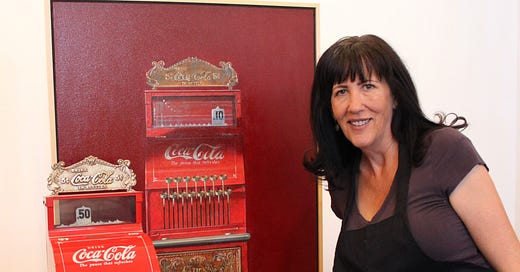




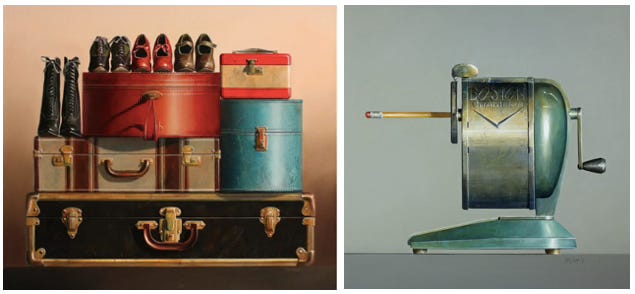
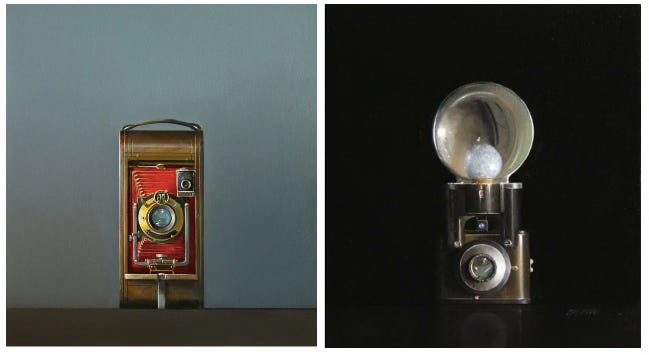
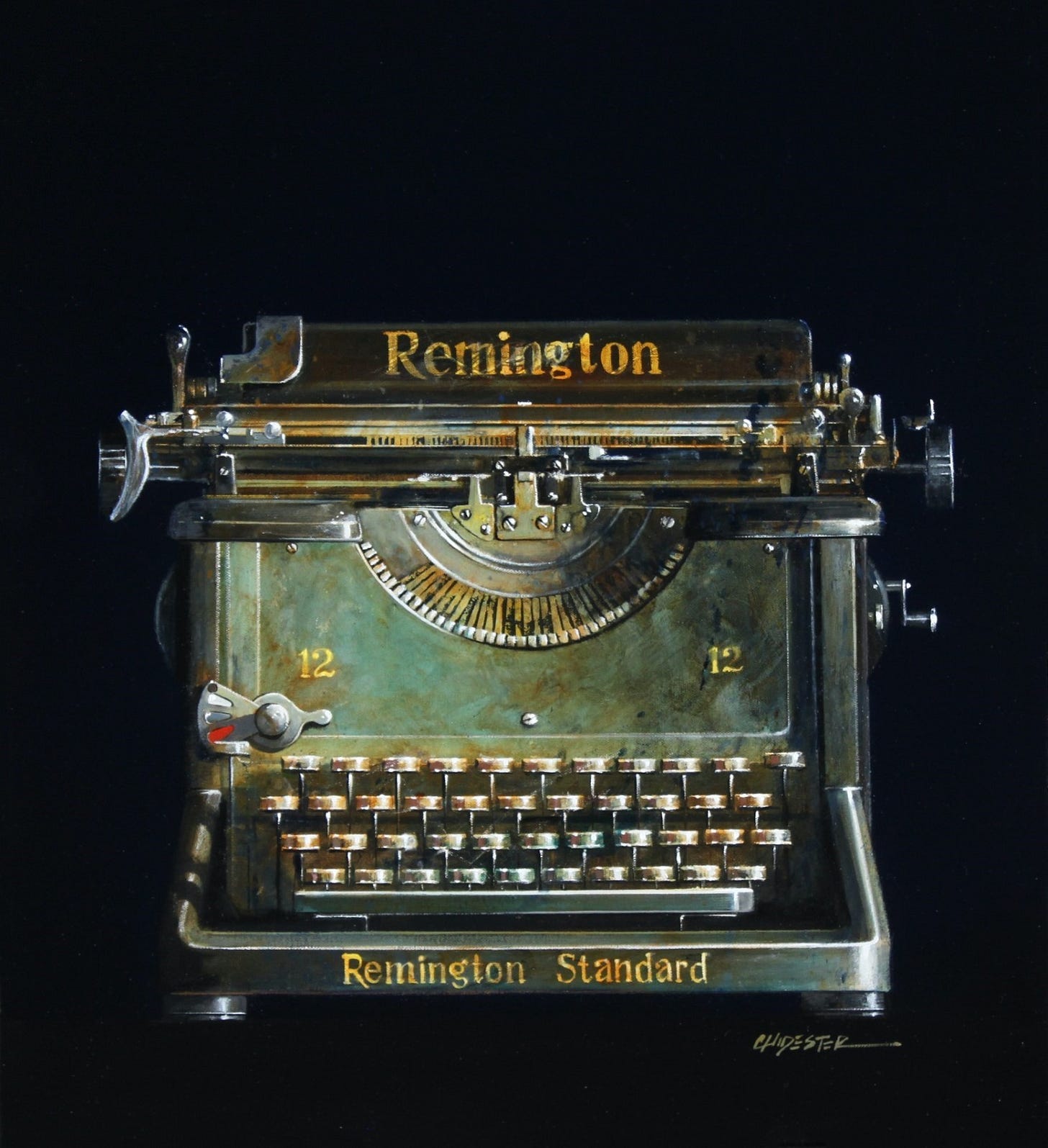

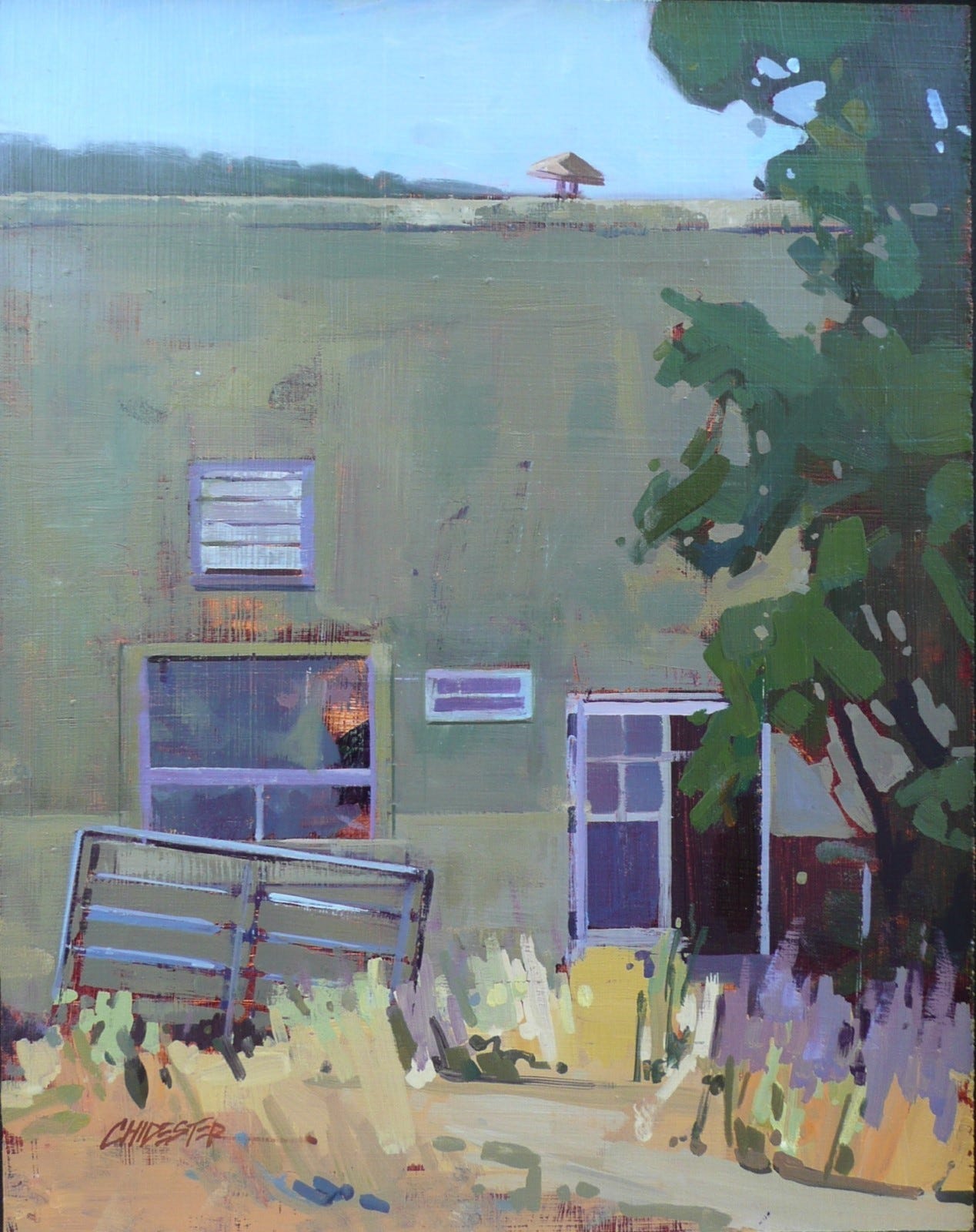
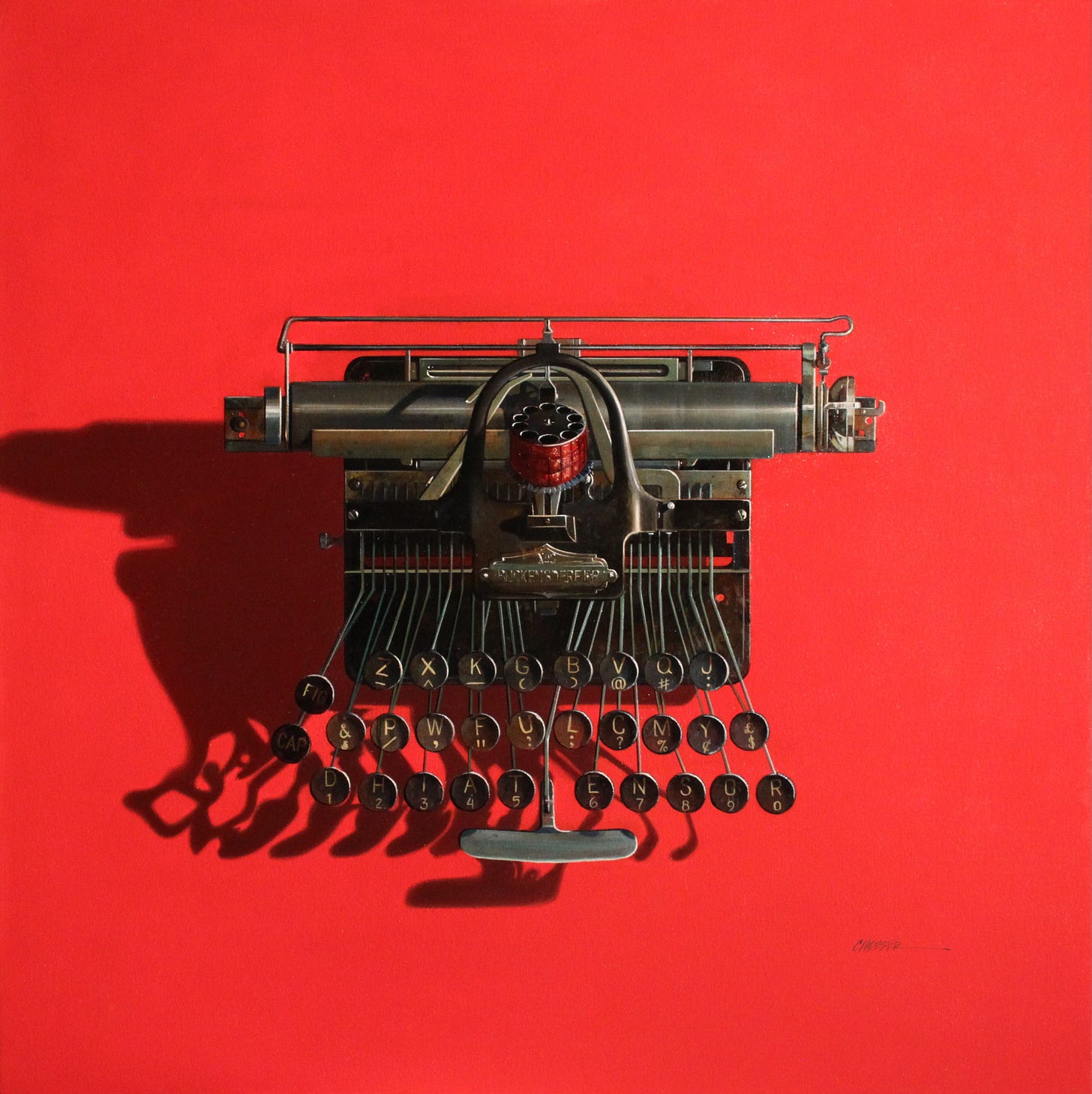
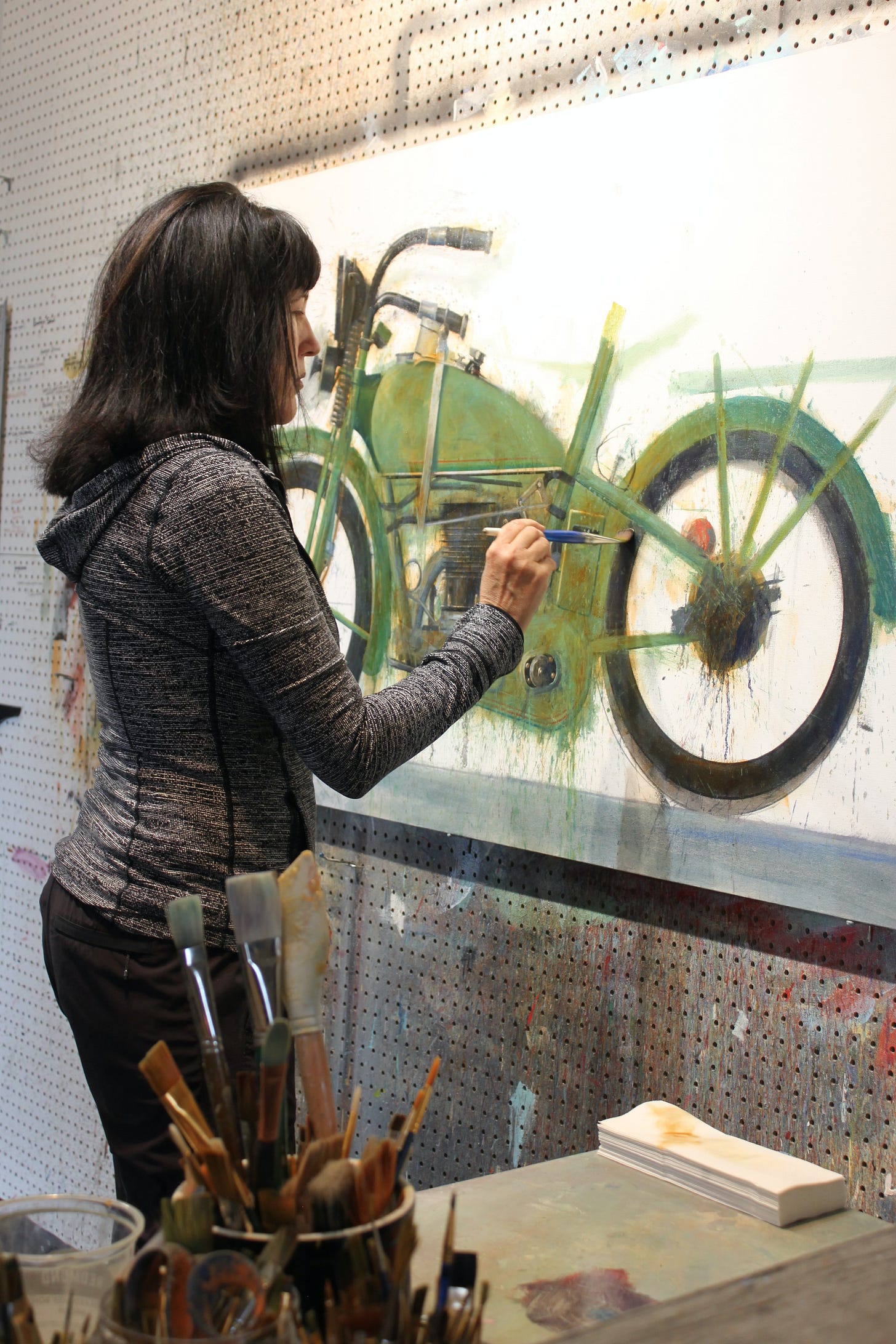

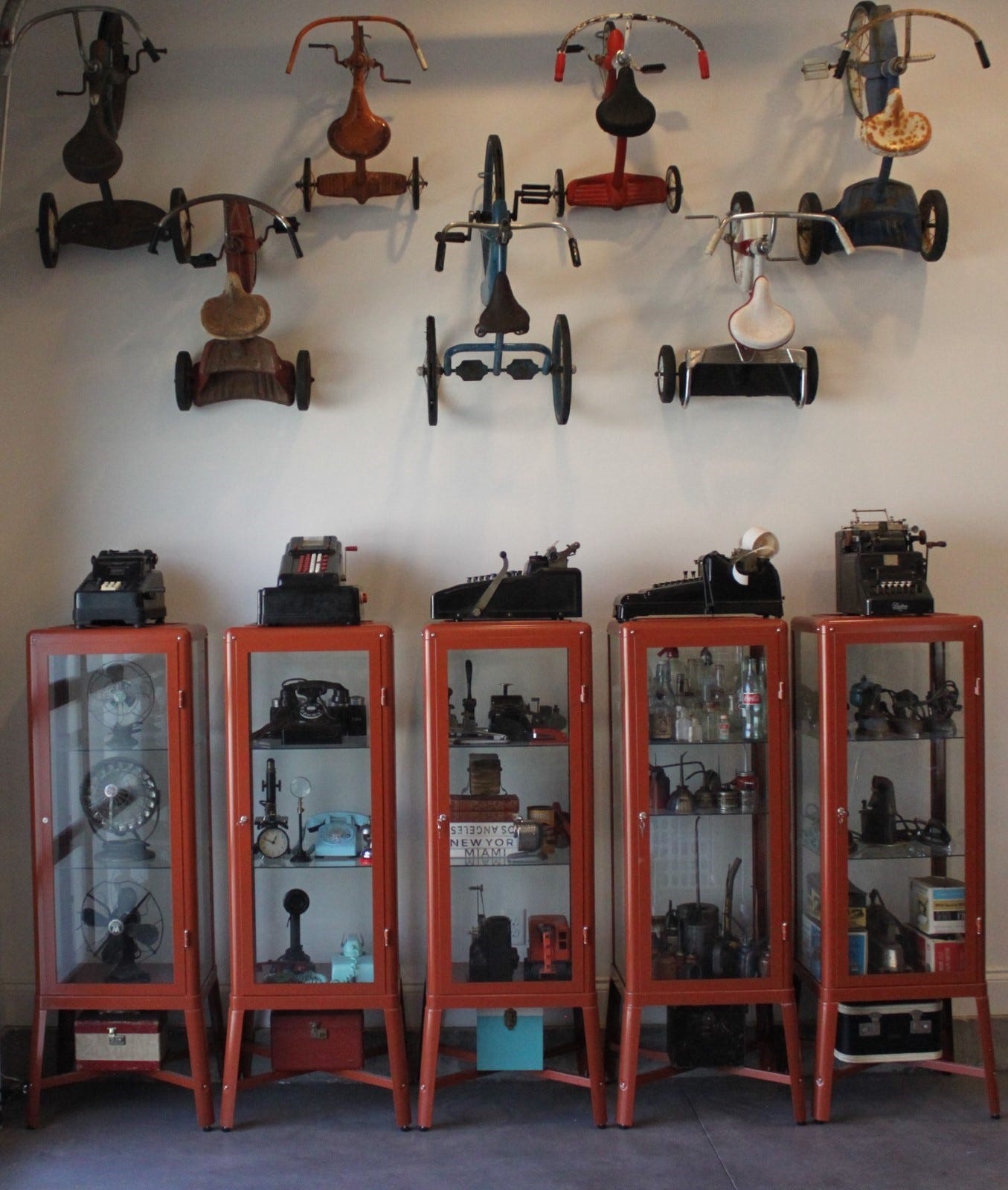

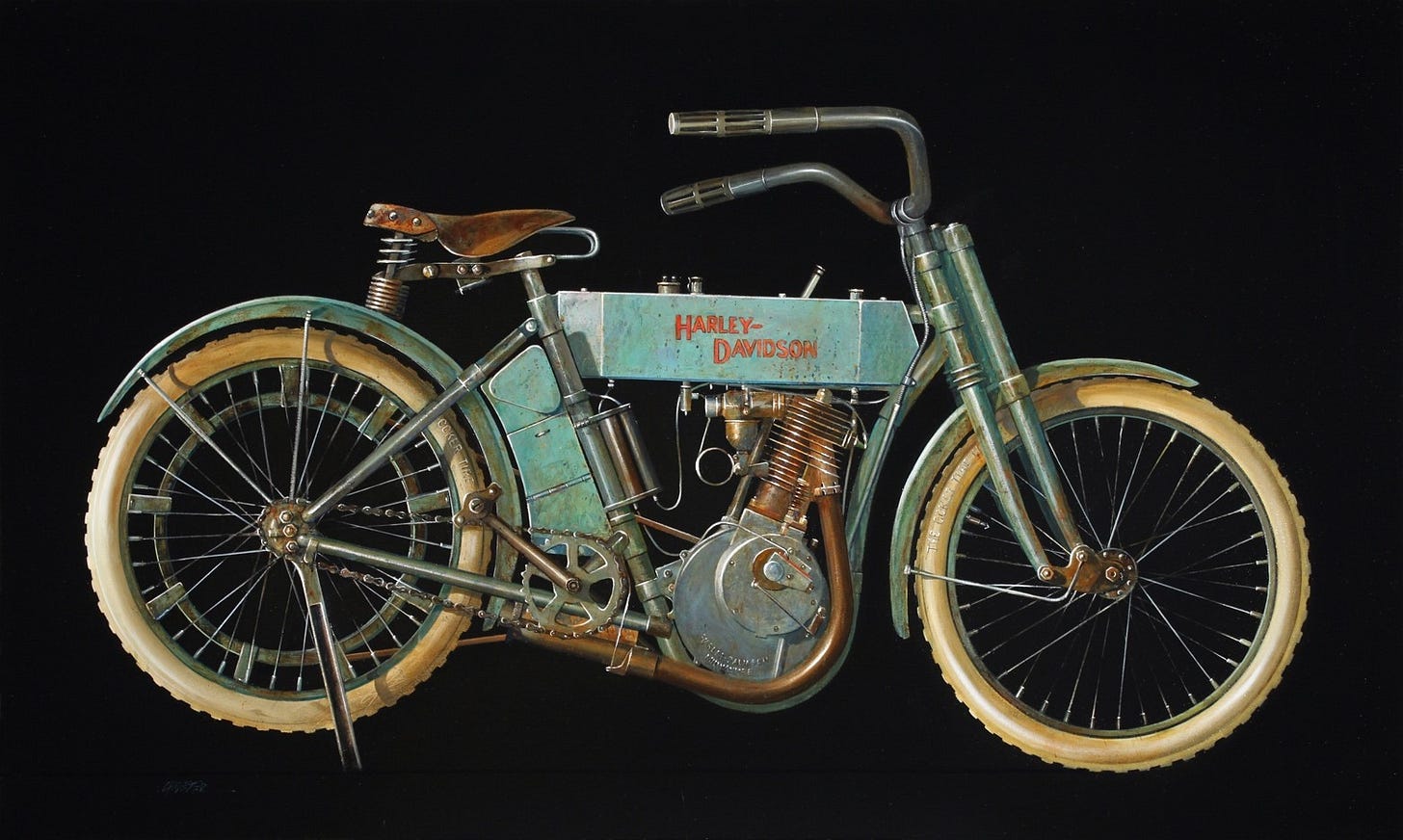
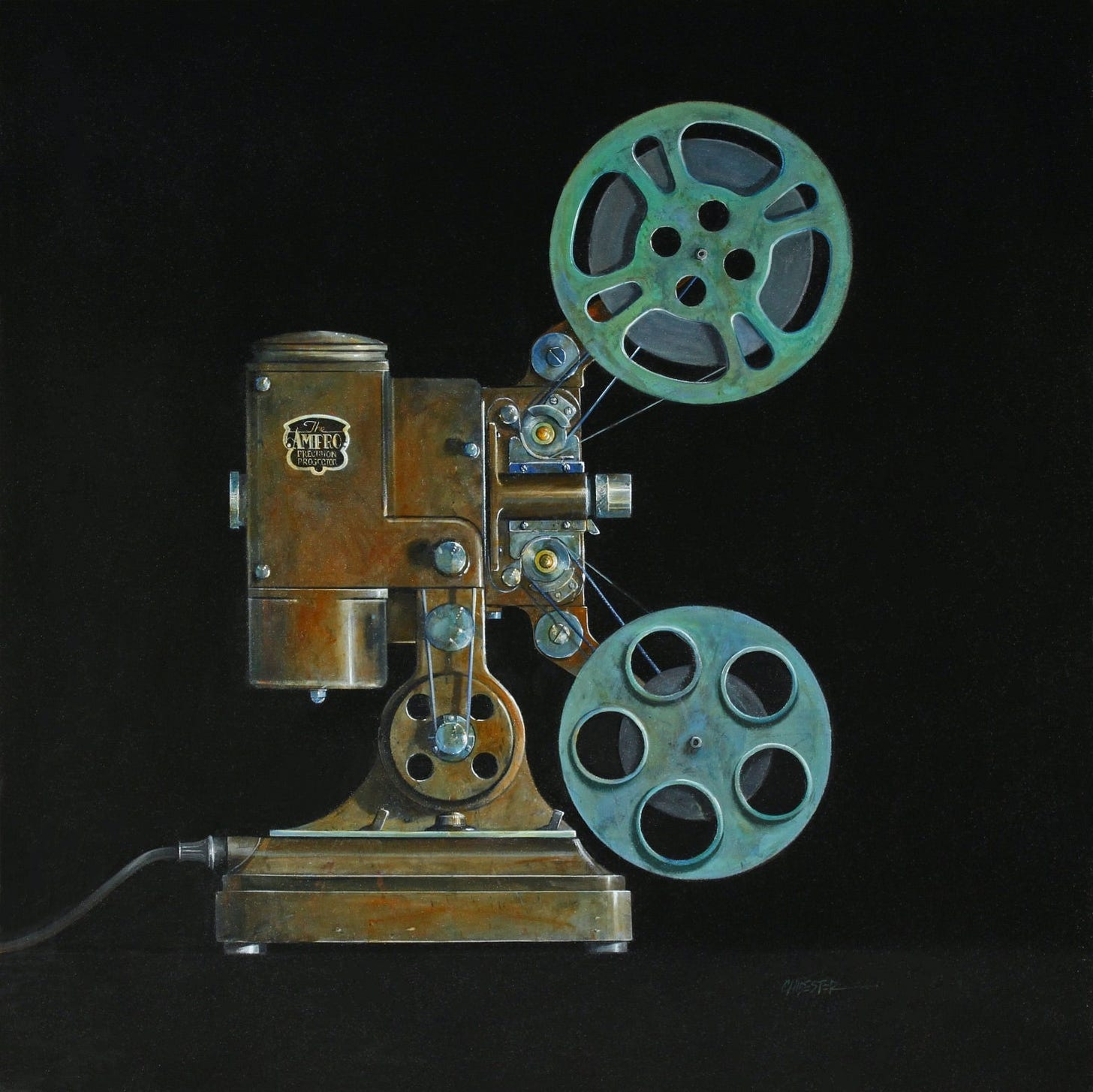
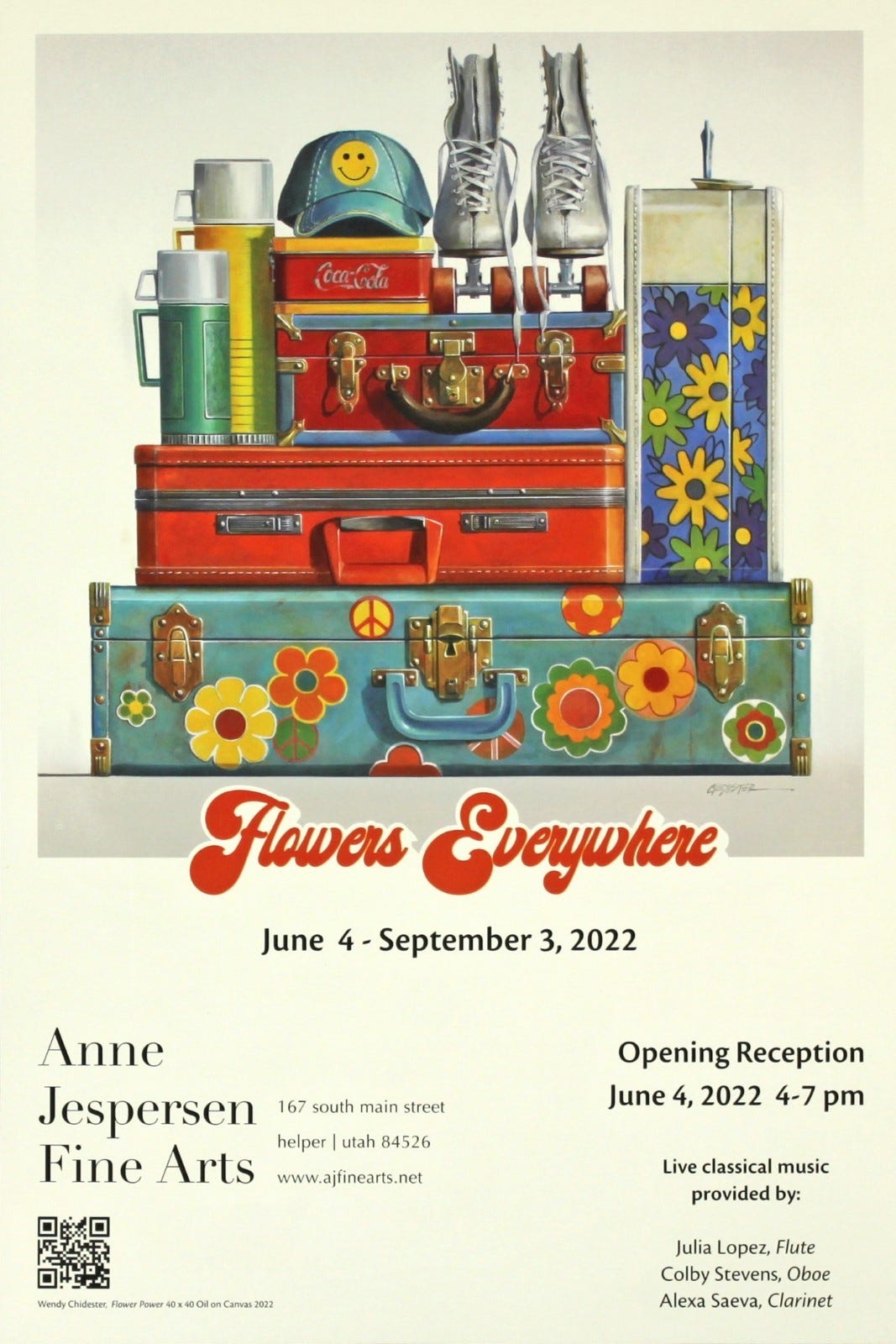
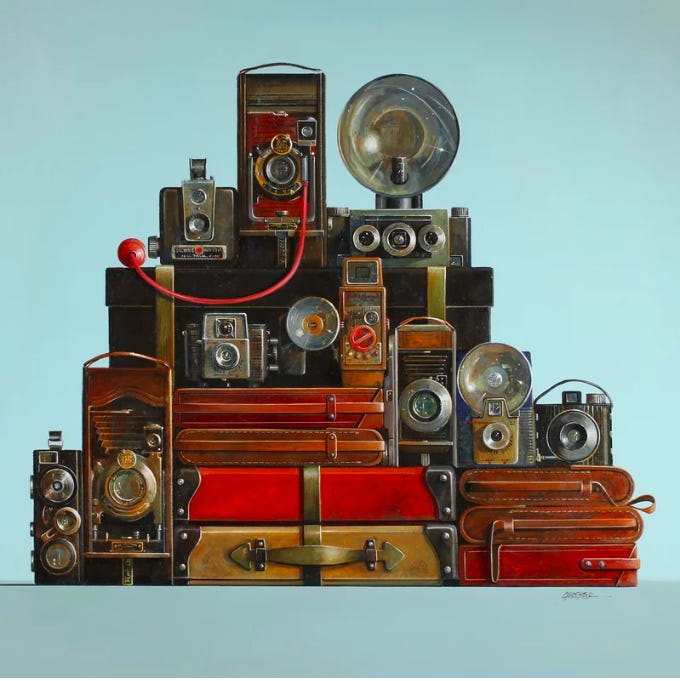
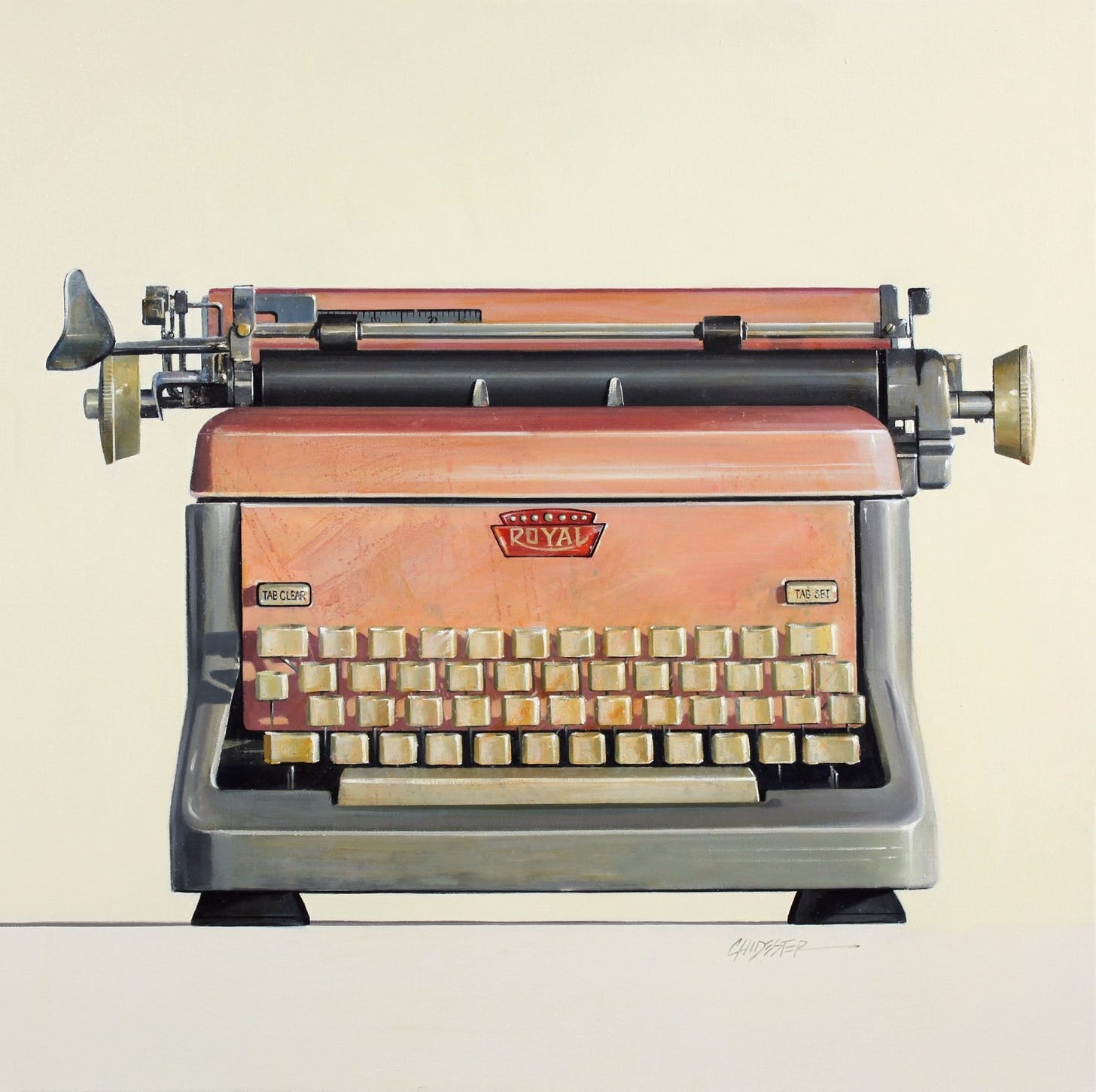
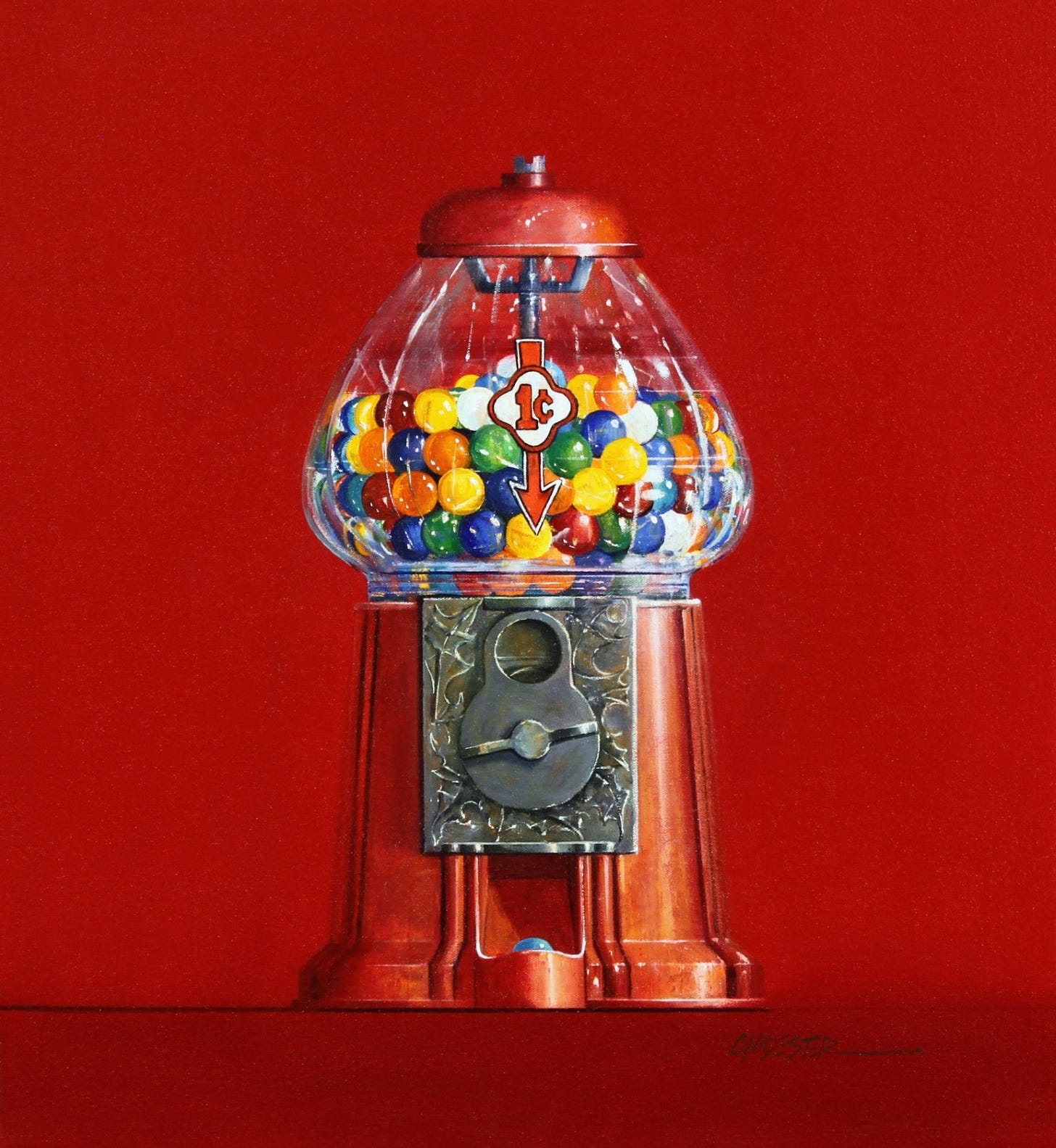
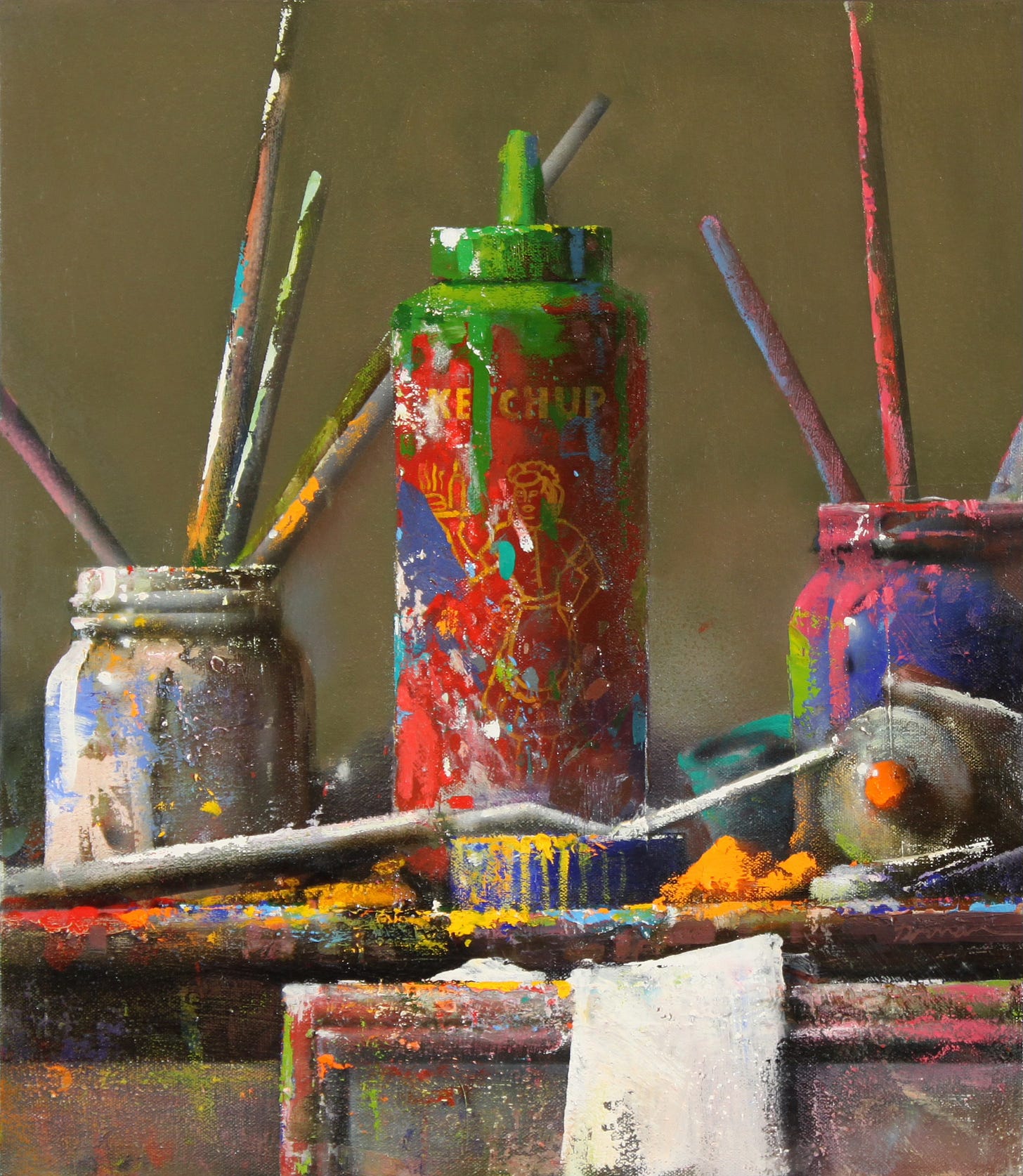


I drove a couple thousand miles to college with two specialized tools, each reflecting the technology of its day. A tan Olivetti typewriter, notable for its compact elegance and efficiency, was precious to my parents. I felt as if I were its guardian for the years I had the privilege to use it. Then there was my graduation gift, a black Sony boombox about 18 inches wide, a foot tall, and maybe 9 inches deep. It, too was compact for its time, but what it offered was mind-boggingly inferior to the tech we carry in our pockets today. That was then, though, so I took pride in having a boombox that housed a black-and-white TV, a radio, and a cassette player. I couldn't have produced the typewritten thesis without the Olivetti, calmed my nerves without the classical tapes I played on the boombox, or watched the 1979 hostage crisis in Iran unfold without being riveted to my 4-inch by 3-inch TV screen.
How fun to reflect, Amy! Thank you for another fascinating story.
Wendy Chidester's paintings are spectacular! I find the vintage objects that she paints to be beautiful all on their own and she brings them to a whole new level. I have my pink Schwinn bike with white wall tires from the 60s. I love it, but it is in the attic and I think I would have trouble finding a buyer so I am glad to know that someone appreciates the era. Thanks Amy!